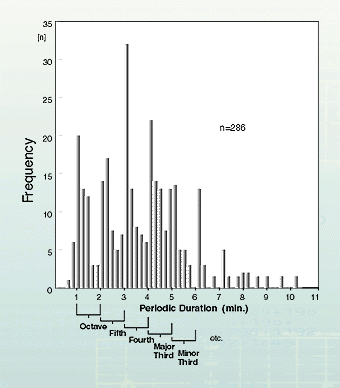| FREIE DEUTSCHE UNIVERSITÄT |
| SCIENTIFICALLY INTRODUCING UNIVERSALITY TO THE UNIVERSITY |
Prof. Dr. med. Gunther Hildebrandt • Chronobiological Aspects of Music Physiology
In contrast, the rhythms of the metabolic system can no longer be modulated in their frequency. On the contrary, each functional area has a series of different pre-formed frequency bands which, according to the demands on performance, are utilized in a rapidly changing manner. All these frequency bands, however, relate to each other in simple whole numbered frequencies, and are so subject to a harmonic-musical order.
The rhythm of the stomach peristalsis, for instance, with its wave interval of approx. 20 seconds has a frequency ratio of 3:1 compared to the one-minute basic rhythm of the fundus musculature of the stomach and the contraction rhythm of the duodenum a ratio of 4:1 compared to the rhythm of the stomach peristalsis.
An isolated piece of smooth intestinal musculature shows spontaneous-rhythmic contractions whose periodic duration constantly changes in whole numbered jumps (illustration 8). There are probably musical-harmonic time structures embodied in each individual cell which correspond to the harmonic interval proportions.
The rhythm of the stomach peristalsis, for instance, with its wave interval of approx. 20 seconds has a frequency ratio of 3:1 compared to the one-minute basic rhythm of the fundus musculature of the stomach and the contraction rhythm of the duodenum a ratio of 4:1 compared to the rhythm of the stomach peristalsis.
An isolated piece of smooth intestinal musculature shows spontaneous-rhythmic contractions whose periodic duration constantly changes in whole numbered jumps (illustration 8). There are probably musical-harmonic time structures embodied in each individual cell which correspond to the harmonic interval proportions.

Illustration 8
Frequency distribution of the periodic duration of spontaneous contractions in an isolated piece of smooth muscle from a guinea-pig's intestines.
(According to GOLENHOFEN and v. LOH 1970).
In the lower part of the picture the musical intervals are given which correspond to the frequency jumps.
| MEDICAL RESONANCE THERAPY MUSIC® Medical Music Preparations on CD |
| Listening Program: Harmony  |
|
If you like to look at the complete program, |